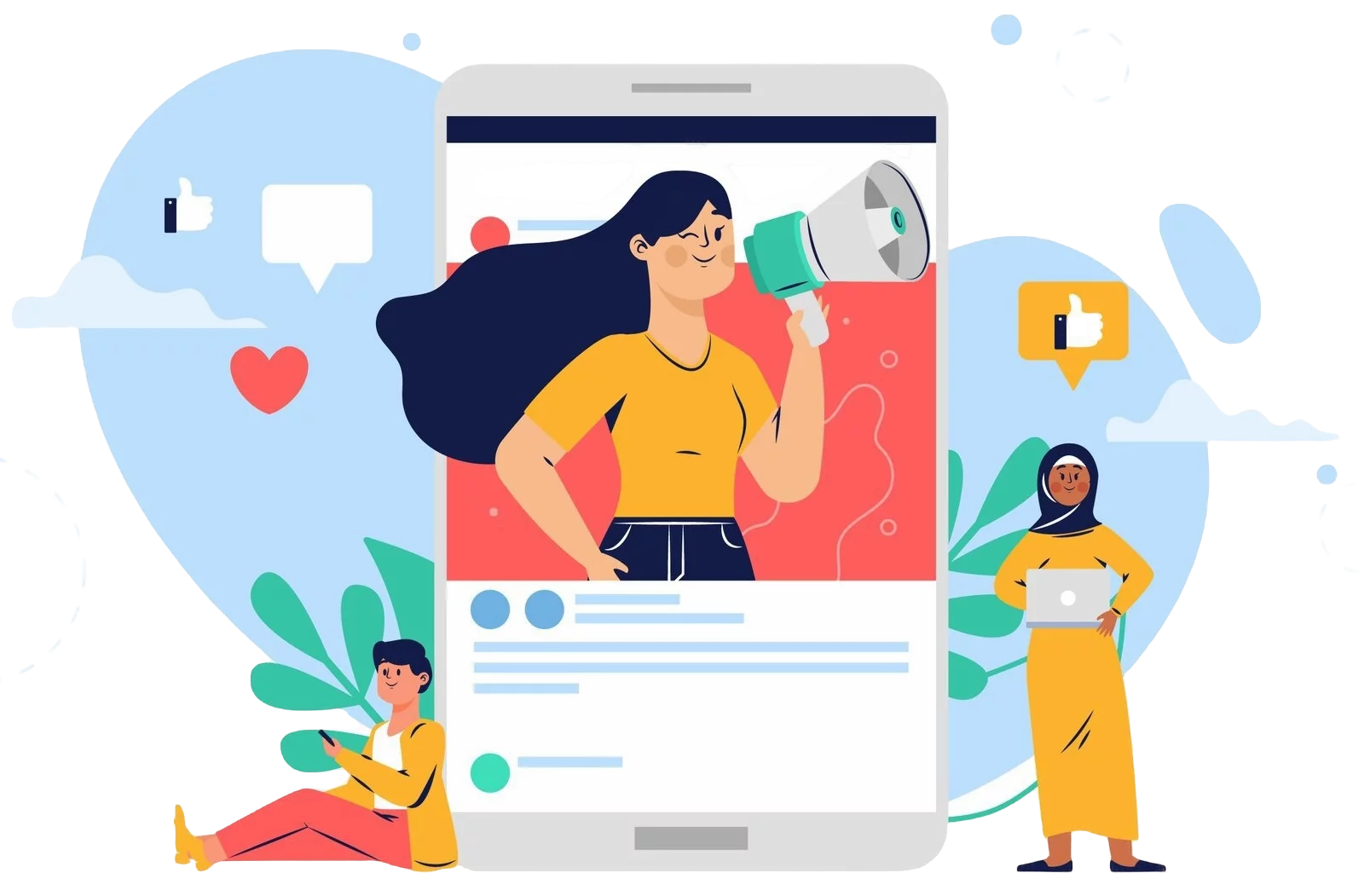The future of influencer marketing in 2025 is on the verge of an exciting transformation. As brands continue to embrace digital platforms and influencers to reach targeted audiences, the industry is evolving at a rapid pace. New technologies, changing consumer behavior, and the continuous rise of social media platforms are all influencing the way influencer marketing works. Let’s dive deep into the future of influencer marketing in 2025 and explore what lies ahead.
1. The Rise of AI and Automation in Influencer Marketing
Influencer marketing has already come a long way, and by 2025, AI is expected to play a bigger role. Automation will make campaigns smarter, faster, and more efficient. Tools powered by AI will help brands identify the perfect influencers for their campaigns with better precision. Algorithms will analyze audience preferences, engagement patterns, and even predict the success of a campaign before it starts.
- Personalized Influencer Selection: AI can help identify influencers whose audiences match the brand’s target demographic more accurately.
- Campaign Optimization: AI can track campaigns in real-time, adjusting strategies for maximum effectiveness. It can analyze data and suggest changes to increase engagement and reach.
For brands, this indicates a more efficient and data-oriented strategy, allowing them to make decisions grounded in cold, hard facts rather than mere speculation. However, the shift requires a thorough understanding of analytics. Although some may resist this change because they prefer traditional methods, embracing data can lead to more informed outcomes. This transformation is essential, but it also presents challenges that must be navigated carefully.
2. A Shift Towards Micro and Nano Influencers
While macro and celebrity influencers have dominated the market for years, the future of influencer marketing in 2025 will see a significant shift toward micro and nano influencers. These influencers typically have smaller audiences, but their engagement rates are significantly higher. They create more personal connections with their followers, making them an attractive option for brands that want to connect with niche audiences.
- Authentic Content: Micro-influencers tend to create more relatable and authentic content, which resonates deeply with their audience.
- Higher Engagement: With smaller, more engaged communities, micro-influencers see higher engagement rates compared to larger influencers. This can lead to better ROI for brands.
By 2025, companies will come to understand that the magnitude of an influencer’s following is not as crucial as the quality of the relationship they maintain with their audience. This shift will render influencer marketing more accessible to small and medium-sized businesses—especially in India—because the trend of hyper-local influencer marketing is expected to flourish. However, it is important to note that while follower count has traditionally been viewed as vital, the focus is shifting; although many marketers still prioritize numbers, authentic connections are becoming paramount.
3. User-Generated Content (UGC) Will Be the Heart of Campaigns
User-generated content (UGC) has been gaining traction in recent years, and by 2025, it will be at the center of influencer marketing strategies. UGC is authentic and relatable because it comes directly from the consumers themselves. This content builds trust and credibility, which is essential for brand success in the modern marketing landscape.
- Boosting Engagement: Brands will leverage UGC in campaigns, using it to build trust and foster engagement. UGC will be encouraged through challenges, reviews, and user submissions.
- Collaborations: Influencers will also become content creators, not just promoters. As a result, brands will collaborate with influencers to create content that feels genuine and blends seamlessly into their audiences’ feeds.
UGC is not merely a fleeting trend; it represents an approach that aligns perfectly with the increasing desire for transparency and authenticity in brand marketing. Companies such as Hobo.Video are already integrating UGC into their campaigns to drive both brand loyalty and authenticity. However, the challenge remains: how can brands effectively harness this powerful tool? Because consumer expectations continue to evolve, this question becomes crucial. Although many firms recognize the value of UGC, they must navigate the complexities involved in its implementation.

Amplify Your Brand,
One Influence at a Time.
4. Video Content Will Dominate Social Media Platforms
By 2025, video content will continue to be the king of social media, with platforms like TikTok, Instagram Reels, and YouTube Shorts leading the way. Videos have a unique way of capturing attention and holding it, making them highly effective for influencer marketing campaigns.
- Short-Form Video: Short-form videos are already widely popular, and they will become even more important as attention spans shorten. Influencers will be able to create quick, engaging content that resonates with their audience.
- Live Streams and Interactive Content: Interactive features like live streaming will become more prevalent. This allows influencers to directly engage with their audience, answer questions in real-time, and promote products in a more personal manner.
As video content continues to gain significance, brands must seek out influencers who excel at crafting videos that captivate viewers and drive conversions. Influencer marketing will, however, rely more heavily on platforms that prioritize video content to ensure that brands remain relevant in the fast-paced social media landscape. Although this presents challenges, it also offers opportunities because engaging video content is crucial for success.
5. Greater Focus on Influencer Authenticity
In 2025, authenticity in influencer marketing will be a non-negotiable requirement. The days of overly polished, unrealistic influencer endorsements will be behind us. Consumers, especially the younger generation, value transparency and genuine connections with influencers. Brands that fail to recognize this shift will find themselves disconnected from their audience.
- Real-life Stories: Brands will encourage influencers to share real-life stories, behind-the-scenes content, and unfiltered opinions.
- No-Filter Content: Influencers will be encouraged to produce content that doesn’t look overly edited or staged. This kind of content helps build trust and fosters long-term brand loyalty.
At the heart of influencer marketing is an emphasis on establishing trust. Consumers are increasingly selecting brands that resonate with their values; however, influencers will play a pivotal role in conveying this message. Although many factors influence consumer choices, the role of trust becomes paramount because it determines the effectiveness of these endorsements.
6. The Growth of Influencer Marketing Analytics
As influencer marketing continues to grow, the need for data-driven decision-making will become even more critical. In 2025, influencer marketing analytics will be a major game-changer. Brands will increasingly rely on detailed metrics to measure the success of their campaigns.
- Engagement Metrics: Metrics such as likes, comments, and shares will continue to be important, but more focus will be placed on deeper metrics, like how many followers actually convert into customers.
- ROI Calculation: Brands will demand clear reports showing the return on investment (ROI) from influencer marketing efforts, helping them determine which influencers and strategies work best.
The future of influencer marketing will become progressively data-driven. This shift allows brands to make smarter decisions, more informed choices and optimize their campaigns to achieve superior results. However, the challenge lies in interpreting the data accurately. Although the abundance of information is beneficial, it can also be overwhelming. Because of this complexity, brands must develop strategies to harness the data effectively, but they must also remain adaptable to ever-changing trends in the market.
7. The Emergence of Virtual Influencers
The emergence of artificial intelligence (AI) and digital technology has led to a significant shift in influencer marketing; this shift is characterized by the rise of virtual influencers. However, while some may embrace these digital personas, others remain skeptical about their authenticity. Although they can engage audiences effectively, the question arises: do they truly connect with consumers on a personal level? Because of these complexities, brands must carefully consider their strategies. This evolution in marketing presents both opportunities and challenges.
- AI-Generated Influencers: Virtual influencers are computer-generated avatars that can be designed to fit a brand’s image. They can be programmed to interact with followers, create content, and endorse products just like human influencers.
- Cost-Effective Option: For brands, virtual influencers can offer a cost-effective alternative to human influencers, with fewer logistics and potential risks involved.
While virtual influencers are still a relatively new concept, they have the potential to disrupt the influencer marketing landscape and open up new opportunities for brands to engage with their audience.
Conclusion
The future of influencer marketing in 2025 is bright, filled with new technologies, more authentic content, and deeper engagement with consumers. From AI-driven influencer selection to the emergence of virtual influencers, the landscape will continue to evolve. This presents exciting opportunities for both brands and influencers alike. However, the dynamics of this environment are changing rapidly, because technology is advancing at an unprecedented pace. Although challenges may arise, the potential for growth remains significant. Influencers will find new avenues to engage their audiences, but brands must also navigate this complex terrain to optimize their strategies.
About Hobo.Video
At Hobo.Video, we understand the importance of staying ahead of the future in influencer marketing. Our AI-powered platform offers a unique network of influencers, UGC creators, and artists who help brands achieve their goals through tailored campaigns. Whether you’re looking for micro-influencers or top-tier influencers, Hobo.Video’s data-driven strategies will ensure your brand’s message reaches the right audience. With our end-to-end campaign management, we handle everything from influencer outreach to performance analysis, leaving you to focus on growing your business.
So, if you are an influencer, Register here!

